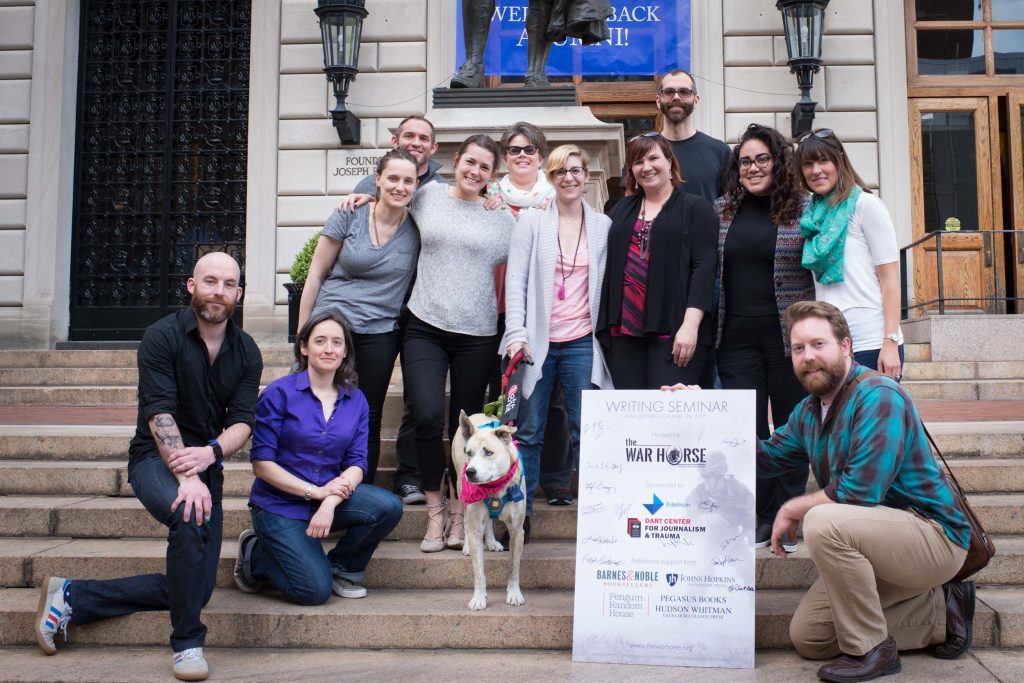Women Fighting and Writing
By Peter Molin
“All wars are boyish and fought by boys,” wrote Herman Melville a long time ago, but it’s hard not to notice all the women-authored and women-centric war-writing that has appeared in the summer of 2017. Much of the new work has taken the shape of memoir and journalism, but new fiction and theater also contribute to the feeling that something different and exciting is happening. Some of the new work is by “First Wave” women war writers such as Siobhan Fallon and Helen Benedict–familiar names in the war-writing scene–but appearing also is many new writers–a “Second Wave”–describing subjects and representing perspectives previously unheard or overlooked. The new work is appearing in print or being performed on stage, but online venues seem to be the medium of choice for publication and discussion of this up-to-the-moment phenomenon. Much credit goes to a highly motivated-and-resourced new organization called The War Horse, of which a profile of founder Thomas Brennan can be found here. The War Horse, in particular, has taken upon itself to promote writing by women-veterans, and even more specifically a War Horse writing workshop that took place in New York City in April, led by David Chrisinger, though not limited to women, has been enormously generative of first-person narratives detailing aspects of life in uniform for women in all its variety and implication. Some examples include:
- “Learning to Breathe Through the Journey of Addiction and PTSD,” by Army veteran Jenny Pacanowski.
- “Drown Proofing, Khaki Shorts. Some Things About Dive School Don’t Change,” by Coast Guard veteran Tenley Lozano.
- “Circumstances, Fortunes, or Misfortunes,“ by USMC veteran Teresa Fazio.
The titles of Pacanowski’s and Lozano’s pieces preview their intriguing storylines; Fazio’s title doesn’t give her story away so readily, but the article describes the author’s post-service trip to India to find meaning in the Sikh tradition of Prasad. Fazio’s not the only female vet with a spiritual bent, either; another War Horse seminar participant (and my former central New Jersey neighbor), Army veteran Supriya Venkatesan, describes her own search for tranquility through Transcendental Meditation in an article titled “I Lived in a Town Where Everyone Meditated Together. Every Day.” Venkatesan already has a list of non-war-related publishing credits as long as your arm on exotic subjects such as bio-hacking, eco-sex, and home-birth, fyi for all aspiring vet-writers searching to break out of rigid identification as a mil-and-war writer.
In the articles I’ve posted, Pacanowski, Lozano, Fazio, and Venkatesan don’t directly address military sexism and toxic military masculinity, but awareness of the difficulty of being a woman in uniform underwrites the ethos and worldview of their writing. Not coincidentally, The War Horse broke the story of the Marine Corps photo-sharing scandal early in 2017—Thomas Brennan’s post-Marine career began as an investigative journalist. Fellow ex-Marine Elliot Ackerman, the author of the novels Green on Blue and Dark at the Crossing, profiled Brennan this summer in a telling piece for Esquire titled “Inside the Nude Photo Scandal That Rocked the Marine Corps”—the despair of two proud Marines as they confront the easily-held misogyny of fellow male Marines is palpable. Appearing at almost the same time as Ackerman’s piece was Andria Williams’ story “The List,” a fictional dramatization of a photo-sharing scandal involving two Air Force officers, published on Afghan Post author Adrian Bonenberger’s The Wrath-Bearing Tree web journal. Williams, whose blog The Military Spouse Book Review has long tracked women’s war writing and military family issues, notes that she presciently first drafted her story in 2013, but filed it away thinking it too far-fetched. Little did she know…. the one-two punch of Ackerman’s article and Williams’ story reinforces the impression that the military’s ability to satisfactorily resolve its gender and sexual harassment/sexual abuse issues anytime soon and without outside help is slim, but if identifying the problem is the first step to a solution, then the authors have done their part.
The battle goes on on other fronts, too. On stage, a new play called Bullet Catchers, currently running in New York City, portrays life in an Army unit through the perspective of the women who occupy leadership positions, as well those who serve in the ranks. Bullet Catchers has already elicited at least two shrewd reviews from wise observers of the passing scene: “Bullet Catchers: Women’s Modern Warfare” by Rachel Kambury posted on the New York City Veterans Alliance website and “A Plausible Reality“ by Teresa Fazio, written for Consequence Magazine.
Finally (though I’m bound to be forgetting something significant), are the appearance of four books in 2017 by First Wave contemporary war-writing women authors. Already out are Elyse Fenton’s volume of verse Sweet Insurgent and Siobhan Fallon’s novel The Confusion of Languages and soon to come are poet Jehanne Dubrow’s Dots & Dashes and novelist Helen Benedict’s Wolf Season. And finally finally, just published is long-time editor of the Veterans Writing Project journal 0-Dark-Thirty editor Jerri Bell’s and Tracy Crow’s anthology It’s My Country Too: Women’s Military Stories from the American Revolution to Afghanistan. It’s My Country Too’s historical perspective reminds us that the current perfect storm of First and Second Wave women’s war-writing didn’t appear brand new spun out of whole cloth. Not to push things back to 1776, as Bell and Crow do, but to a more-recent 2016, important precedents began appearing last year when anthologies such as Retire the Colors, edited by Dario DiBattista, and The Road Ahead, edited by Adrian Bonenberger and Brian Castner, offered robust mixtures of powerful stories by both men and women veterans.

So what to make of it all? The first step, it seems to me, is recognizing, respecting, and encouraging the development. The second step is assessing what women’s war-writing has to tell us, both about life-in-uniform for women and masculine traditions and conventions of war-writing. Third, preparing for the backlash, which will inevitably come in the form of sneers about “the feminization of war-writing” and efforts to reestablish its manly basis. Fourth, ever-more precisely disentangling current notions about military culture, war-winning, and fighting ability from their unproductive entwinement with accepted cultural ideas about manhood and patriarchy, so that the military becomes a better place for all Americans to serve, rather than being a big boy’s club, and applies itself more effectively to winning wars, rather than being an endless employment and get-rich opportunity for flag-wavers, war addicts, mercenaries, and profiteers.

